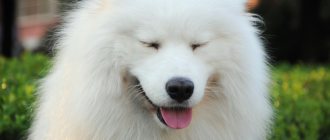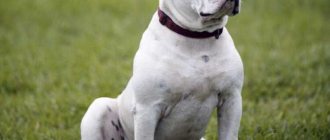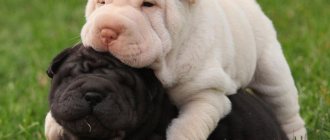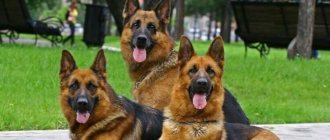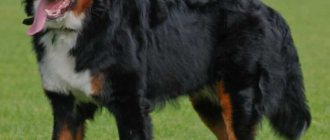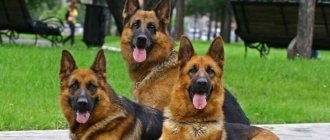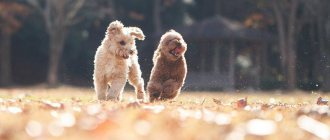History of the Boxer breed
Female and male German Boxer
The ancestors of the German Boxer are bulldogs, mastiffs and bullenbeissers. It was as a result of the mixing of their blood that this breed was born, which began to conquer the world in 1896.
Boxers from the late 19th century and modern boxers are not exactly the same thing. In those early years, they were used as shepherds, for transporting goods and hunting wild boars and bison. Often early representatives of the breed became participants in dog fights and even bullfights. During the First World War, the German army successfully used them as postmen and scouts. At the same time, German boxers also showed themselves as guide dogs. Later, dogs of this breed also revealed their “creative” talents, successfully performing in circus and theatrical performances.
An interesting version is the earlier origin of boxers. Some researchers claim that their direct ancestors are the Tibetan Great Danes, who ended up in Rome and Greece back in ancient times. It is believed that ancient boxers were larger and more aggressive. Their inherent bloodthirstiness helped them cope well with military tasks. They were used for protection and as a baiting dog during the hunt for large forest game, as well as in the popular entertainment of those times - dog fights, which in terms of the intensity of passions were practically not inferior to gladiatorial ones.
Since the end of the century before last, the German boxer began to conquer the world, he had many fans in different parts of the world, who even opened clubs dedicated to this incredibly stately, dignified and beautiful dog. Her appearance seems aggressive (sometimes it may seem that she is ready to rush at a stranger and tear him apart), but behind her lies a good nature and an easy-going character. This is a great merit of the breeders, who did everything possible to add such traits as kindness and balance to agility, endurance and speed of reaction.
When a dog wants to play, it begins to move its paws in the air, as if boxing. This special manner, which makes it unlike other dogs, predetermined the name of the breed. According to the owners' reviews, boxers have all the necessary qualities for living in a family, so they are the best!
Kinds
Often the types mean “German” and “American” boxer. This is not entirely true. The American breed of Boxers emerged after World War II, when American soldiers brought Boxer puppies from Germany. The breed becomes so popular that for many years it was included in the top 10 AKC breeds, and at one time the most common in the United States.
It is difficult for an uninitiated person to notice the difference between these 2 dogs: Germans are heavier built and have larger heads than Americans.
But with all this, this is one breed, and mixed breeds between them are considered purebred puppies.
Features of the German boxer
Boxer puppy
A German boxer at the age of 18 months is already an adult dog, fully developed physically. However, by the age of one and a half years the inner world still remains “childish”. For this reason, attempts to train a dog during a period of his emotional immaturity are practically futile, that is, he does not respond to commands, and the owner even begins to think that he is communicating with a deaf person. But at one fine moment a breakthrough comes in training, and your pet suddenly begins to understand everything that they previously tried to teach him, but in vain.
The Boxer is a sociable dog, it gets along easily with other four-legged inhabitants of the house, but sometimes the cockiness in its character takes over and it begins to chase the yard cats. It happens that a dog of this breed easily gets into fights with other dogs, and fights are often provoked by him himself. By nature, a boxer is a real fighter; he is dexterous, brave and strong. If you train him correctly, you can raise an excellent guard. The childlike spontaneity inherent in a boxer remains with him throughout his life. The dog shows enviable stubbornness, but never achieves his goal with aggression. His main weapon is humor and charm, which no loving owner can resist.
Representatives of this breed have amazing sensitivity, they are very smart and cunning. Sometimes they can be noisy, which is perceived by some owners as a drawback, therefore, in order to develop the best character traits and minimize shortcomings, boxers must be trained. With the right approach to this task, you can achieve amazing results, as boxers perceive training as a game and easily succumb to it.
Running boxer
Owner reviews
For you, we have collected reviews from real owners of the German Boxer breed:
“Advantages: Very smart, kind breed, good with children. Disadvantages: Restless Skoda, requiring constant attention and physical activity.”
“I got my “German” from an old friend. The dog is wonderful, but very wayward. I think the reason for this is the lack of education in puppyhood. In general, Bill is a wonderful dog and a reliable watchman: he will let anyone into the house, lick him, play, but in life he will not let him out until I give the appropriate command. The only negative: at night he snores like a locomotive, sometimes you have to wake him up to make him quiet.”
“Despite my affection for boxers, I want to mention their shortcomings. First of all, it's drool. Secondly, short hair that sticks into the carpet like needles. I have to vacuum almost every day to keep the apartment clean. Thirdly, intolerance towards other people's dogs, especially large ones. Every now and then you need to look around to prevent a fight. Nevertheless, I recommend this breed to everyone!”
"Calm?! Yes, he’s just a devil from hell, not a dog... He’s constantly running around, freaking out, playing around, well, he’s definitely a clown. Sometimes you just want to strangle him. When I come home, at first I’m angry that the dog won’t even let me take off my shoes, but then I look into his little eyes and understand how he’s been waiting for me all this hard day.”
“The dog is just super, found on the street, running around without a collar. At first we were afraid to take two small children with us, but then we decided, it was a pity. Now he lives with us and we don’t regret it one bit, he’s a great dog!”
Appearance and special features of the breed
Boxers have a stocky build. They are also called "square" dogs because their height and length are approximately the same. A wide and deep chest, coupled with a strong back with a slight slope in the pelvic area, is quite consistent with this body type. At the same time, representatives of this breed do not look squat - rather the opposite. The dogs look stately, they have a proud posture, and all thanks to their dry muscles and lean belly. Their limbs are massive, correctly placed, without curvature, so they do not spoil the “figure”. The Boxer's neck is of medium length, strong and muscular, and the tail is long and straight.
Two boxers playing
A distinctive feature of the breed is a slightly protruding lower jaw, a slightly upturned nose and high-set ears - thin, hanging slightly forward. When circumcised (cupping), they acquire a pointed shape, which gives them the correct position. A Boxer's eyes are dark, intelligent, and they can tell a lot about the breed. You can read curiosity in his gaze; it glows with energy, but not with aggression.
The skin of boxers, with the exception of the forehead and cheeks, fits tightly and does not form any folds. The coat is short, hard and also lies tightly. Only two colors are considered classic for German boxers: red and brindle. The first can range from rich red to light yellow shades. The brindle has its own “extremes”: from golden to gloomy dark. The breed standard stipulates that the stripes should appear as clear lines.
Whatever the color, a kind of dark mask is an invariable attribute on the dog’s face. The presence of white markings is acceptable, giving the breed an aesthetic appearance. White, black, gray dogs with a large number of stripes and spots are considered “rejected”. And one more thing: if you plan to send your pet to an exhibition, then docking of the ears and tail will have to be sacrificed. Experts categorically do not recommend performing such manipulations with a boxer.
general description
- The height of the German boxer is average, approximately 60 cm at the withers. An adult dog weighs from 25 to 32 kg.
- Dogs of this breed have superbly developed and voluminous muscles. Their movements are active, energetic, filled with nobility and strength.
- Boxers, despite their “square” physique, have sufficient substance. That is, they cannot be called clumsy, heavy or, on the contrary, too light.
- They are characterized by balance and often serve as guides for blind people.
- Males are larger than females. Pedigree parents can give birth to up to 7 puppies per litter.
Head
The head matches the proportions of the body and, giving the dog a special identity, does not look too massive or too light.
The muzzle, ideally, is as wide and powerful as possible. The correct ratio of the skull and muzzle provides the boxer with a harmonious head. No matter where you look from - front, side or top - the muzzle relative to the skull remains in the right proportion and does not look too small. The Boxer's head is dry, there are no folds or wrinkles on it. The latter are formed, and this is allowed, only in cases where something has alerted the dog. There are natural wrinkles on the muzzle on both sides. But not everywhere, but only in the area from the base of the bridge of the nose down. A black mask is clearly visible against the general background of the muzzle. Despite the gloomy shade, it does not at all impart gloominess to the dog’s appearance.
The upper region of the skull is not wide, not flat and extremely angular. Its shape is somewhat convex, but not shortened or spherical. The prominence of the tubercle in the occipital region is not excessive. The furrow on the forehead (primarily the area between the eyes) does not differ in depth and is only slightly visible. The area from the forehead to the bridge of the nose has a ledge that is clearly visible. The bridge of the nose is not drooped and, unlike bulldogs, it is not turned up.
Boxer muzzle
Teeth
The lower jaw, if compared with the upper, is slightly longer. Its distinctive feature is its upward curvature. The base of the upper jaw is wide, tapering towards the end. Boxer teeth are in excellent health and very strong. The canines are impressively large and widely spaced. The incisors are located on the same line, very evenly. The form of a dog's bite is undershot.
Eyes
Boxers' eyes are rather large, dark in color, not deep-set and not prominent. The edges of the eyelids are also dark. Dogs look intelligently and at the same time energetically, their gaze is kind and does not carry any threat.
Ears
German boxer
They are located on the sides in the upper region of the skull, their fit is high, and their size is proportionate. In a state when nothing bothers the dog, and there is no need to listen to sounds, they are adjacent to the cheekbones. If your pet is alert, the ears will immediately turn forward, forming a clear bend.
Nose and lips
Thanks to the nose, the dog's muzzle has a complete look, its tip is slightly higher than the base. The lobe is slightly upturned, it is wide, the color is black, the nostrils are also wide.
The upper lip is pronounced and fleshy. It covers the free area formed due to the fact that the lower jaw is longer. The upper lip is supported by the lower canines.
Neck
The Boxer's neck is lean, muscular and at the same time round and long (but not excessively). From the mound on the back of the head towards the withers, the upper border of the neck forms a graceful arch.
Frame
The boxer's withers are clearly defined; the body is supported by strong, developed limbs. The back is wide, with a “pumped up” muscular system, but short and level. The croup is slightly rounded, wide, slightly sloping. The pelvis, especially for females, is wide and long.
The chest area is so deep that it reaches all the way to the elbows and is equal to half the height of the dog at the withers. Its front part is powerful and superbly developed.
The underline has an elegant curve towards the ischial tuberosity. The groin cannot boast of length, it is moderately toned.
Tail
Boxer with undocked ears and tail
Has a fairly high seating position. Usually it is not stopped, that is, it is left unchanged - the way it is by nature.
Limbs
If you stand in front of the dog, you can see that the front legs are parallel to each other. The bones of the limbs are strong.
The blades are firmly connected to the body, differ in length and are inclined. The shoulders are also long, located at the correct angle relative to the shoulder blades. The elbows are not pressed too tightly to the chest.
The forearms are also not short at all, they are located vertically and are muscular. The pasterns, on the contrary, are short, almost vertical. The wrists are clearly defined: they are strong, but not too massive.
The front paws have a rounded shape, they are small in size, compact, the pads are hard and elastic. The hind legs are naturally well-pumped, straight, the hips are distinctly wide and long.
Boxing team
The hind legs are slightly longer than the front legs. They are also compact, the pads are hard and elastic.
When the boxer is calm, his knee joints move forward so clearly that they even reach a conventional perpendicular, outlined in the direction of the surface from the iliac tuberosities.
Muscularity is also inherent in the legs. The hock joints, although not massive, are strong and well defined.
Wool
The hair fits tightly to the skin, it is short and hard, and shiny.
Color
Boxers come in red or brindle color. Any shade of the first is allowed, from light yellow to red-brown. The most typical for the breed, or, in other words, preferred, are reddish-red tones.
The brindle color has the appearance of dark or black stripes on a red background. They should be clearly defined and contrast with the background. White areas are not forbidden and, accordingly, are not considered a “defect” of the breed - on the contrary, they can even decorate the dog.
Red boxer
Brindle boxer
Possible defects
Variations that do not meet the breed standards listed above are considered faulty. These deficiencies should be assessed according to their severity and the extent to which they affect the dog's daily lifestyle and health.
Disqualifying faults
The white boxer is considered rare and can cost more than dogs that meet the breed standard.
Physical: congenital bobtail. Behavioral: cowardice or, conversely, aggressiveness.
Defects of the testes: in healthy male dogs, they should be normally developed, completely descended into the scrotum.
Any representative of the breed showing obvious physical defects or behavioral abnormalities shall be disqualified.
Lifespan
A German boxer lives on average 11-12 years. There are happy exceptions to this rule.
general description
The German bulldog (the photo shows us a dog with a rather strict appearance, but the kindest heart) is a very loyal animal that has a calm character. From the first days of being in the family, the puppy considers its owners to be its best friends. And he will never forget this. The Bulldog loves small children very much. This is one of the most playful guard dogs. And this quality does not disappear until the end of life. A tiny puppy and a venerable bulldog of advanced age will equally carry toys for you, forcing you to play with them until you drop.
This is a very smart dog for which training is not a problem at all. He picks up commands on the fly, after which he will fulfill all requirements without fail. A fearless defender and a real tank - this is how the animal can be dubbed. It was these qualities that were taken into account when the German M41 was named. “Bulldog” is the name the car received.
Photo of an adult boxer
Boxer character
Cheerful, playful, curious, cheerful, energetic - these traits fully characterize German boxers.
These dogs are also loyal, becoming very attached to their owner and his family members. Positive traits stay with a boxer all his life; he likes it when there are a lot of people and noise around him. A boxer who has gone through a good training school gets along well with small family members, treats them with care, never offends them, and plays with them with pleasure. He will not only become an excellent companion for your child, but also a reliable guard.
Boxer with a child
A representative of this breed, subject to good upbringing and social adaptation, will get along well not only with other dogs living in the house, but even with cats. However, the real “temptation” for them is small animals and birds. Your pet can be taught not to touch them, and he will not do this in front of you. But, as they say, it’s better not to leave the boxer alone with them.
The boxer loves to fool around and warmly greets all the people he knows. He never loses his vigilance and therefore will be a good protector for his household. This brave, athletic breed sometimes retains its excellent guarding and guarding qualities until a very old age. In order for the dog not to show his not the best qualities - excessive noise, stubbornness, and sometimes uncontrollability - he needs an owner who will dominate him.
Adults have a calm temperament, which is a direct result of proper training at an early age. The popularity of the breed is precisely due to this very poise, coupled with natural intelligence and tolerance towards people and other pets. The boxer shows the most tender feelings towards his owner and shows with all his appearance that he really likes being around. If you do not cultivate communicative qualities in him, the dog will show suspicion of strangers all his life, bark at them, and refuse to let them near his owner.
The boxer retains his childlike activity and spontaneity until the age of 2-3 years, although physically he matures by the age of one and a half years. Many owners who are not aware of the intricacies of the breed complain that the Boxer does not understand the commands that are taught to him. In fact, it takes time for a dog to learn and retain new information. The owners are then convinced that this is so: at one fine moment the dog begins to do everything that it seemed to have been taught to no avail for a long time.
Nutrition: what to feed
Dogs can be fed both industrial food and natural products. With a natural diet, the diet should consist of the following products:
- lean meat;
- offal;
- cereals;
- lean sea fish;
- dairy products;
- vegetables, greens;
- boiled eggs.
What to feed a boxer is prohibited:
- sweets, flour products;
- seasonings;
- smoked meats, marinades, fatty and fried foods;
- tubular bones.
Industrial feed should only be of high quality.
Boxers love to eat, and therefore the owner needs to monitor the portion size
Training and education
Boxers are smart, well-trained dogs. At the same time, they are stubborn and perceive new information selectively. They refuse to carry out many commands, preferring to obey only those that they like.
High five!
Some owners believe that training a representative of this breed needs to be done using the “carrot and stick” method, that is, punishing for disobedience and rewarding for precise execution of commands. However, the “whip” in this technique will be superfluous, since boxers react poorly to punishment. Various incentives (praise, treats, awards) make them more receptive to training. By using a specific set of commands, you are sure to achieve excellent results during the training process. With the correct and clear formulation of tasks, the boxer remembers the learned commands for a long time.
Boxer training usually begins from the moment the puppy is in the house, and full training begins from three months. First of all, the dog is taught basic commands, such as “Sit!”, “Lie down!”, “Near!”. When your pet has mastered them, you can begin teaching the “Come to me!” command. This command is considered the main one; the boxer must perform it in any situation and the first time.
The Boxer loves the outdoors very much, so the countryside suits him perfectly. But even in an apartment, your four-legged friend will feel good if you regularly take him for walks in a large park, where he can take long walks. The dog will be an excellent companion for an owner who loves morning or evening jogging. He is ready to spend the whole day outdoors.
Dogs of this breed are often left to frolic in the courtyards of houses, first making sure that the fence is strong. The latter is not out of place: there are many cases where German boxers jumped over the fence and ran away. Their jaws are so powerful that, if left alone at home, they can even bite through the lock on the door.
Key facts
The German Boxer is a large, strong, smooth-haired dog bred in Germany. The abbreviated name of the breed is simply Boxer. Thanks to its outstanding conservation data, the animal is widespread not only in the country of origin, but also far beyond its borders.
The characteristics of the Boxer breed say that a stable nervous system allows these dogs to be used as bodyguards, watchmen, and also for work in law enforcement departments. The Boxer is very smart and at the same time has a balanced character, which allows him to become a guide for a visually impaired person.
The pet becomes a true friend for its owner, and thanks to its great mobility, it is an excellent companion for long walks in the fresh air. However, the dog shows sociability, devotion, and friendliness only towards the owner or other animals; the attitude towards a stranger will be cautious, even wary. The pet greets strangers with loud barking, but socialization at a young age solves this problem.
The description of the Boxer breed mentions that dogs live equally comfortably in private houses and apartments. They treat children well and take part in games with them with pleasure. Despite its large size, the dog loves to lie on the sofa to relax with its owner.
Boxers are known for their well-developed muscles and strong, bony physique. The life expectancy of boxers is short compared to other breeds: only 11-12 years, but there are long-livers. Females look more compact than males. The weight of an adult dog varies from 25 to 32 kg. Bitches are 53-59 cm tall; in males, the height at the withers reaches 57-63 cm.
Care and maintenance
Wherever you place your pet, in an apartment or a country house, it will fit in perfectly everywhere. He will be comfortable even in an ordinary kennel, but on the condition that another dog shares this “living space” with him.
In general, German Boxers are quite easy to care for, but they do not tolerate cold and high humidity well.
Since Boxers have short hair, it, unlike long-haired breeds, does not get tangled or tangled, and therefore does not need frequent combing.
Frequent bathing is not recommended for Boxers. If your pet gets dirty during active play, simply wipe the dirty area with a damp cloth.
Since a boxer is very active by nature, a sedentary lifestyle is contraindicated for him, he must receive maximum physical activity. For the healthy development of a dog of this breed, a balanced diet is also required.
The dog's eyes require special attention. Tear secretions or dust often accumulate in their corners, and a soft handkerchief is enough to remove them. If your dog's eyes are red, a soothing ointment will help. However, do not self-medicate: the drug must be prescribed by a veterinarian.
Dirt may accumulate in the ears. To remove wax and dust from the ear, just wipe it with a handkerchief wrapped around your finger or wipe it with a damp swab. Cleaning a Boxer's ears with a cotton swab or putting alcohol in them is strictly prohibited.
A boxer's claws should not touch the floor when walking. Otherwise, they need to be cut off. For this purpose, special forceps are used. The procedure should be carried out no more than twice a month, otherwise you will cause discomfort and pain to your pet.
Boxer in the apartment
Mating
- Dogs become sexually mature at 18-20 months. By this time, the bitch should already be in her third heat. Dogs can be bred for 10-15 days; it is important to select such pets so that their qualities complement each other and are passed on to the offspring in the right form.
- It is important to introduce boxers and walk them together . Not all individuals accept each other. The bitch should be open and flirt with the male. After this, it is customary to take them to the boy’s territory, but if the female is restless, it is important to change the place.
- For the first time, you can invite a specialist who will help both the dog and the owner. He will explain the rules of mating and show how to help your pet.
- Breeders must hold the bitch and help the dog. After entering the “castle,” you cannot let your pets go; it is better to hold on for the next 30-40 minutes. The mating is repeated after a couple of days.
Boxer health and illness
Two boxers on a leash
Despite the fact that boxers are given 11-12 years of life by nature, on average they rarely live to be 10 years old. The reason lies in a weak immune system. Because these dogs are uncomfortable in cold temperatures, they are prone to hypothermia, colds and allergies. To ensure that their health is not endangered, the premises in which German boxers are kept must be dry and draft-free. In wet and windy weather, it is better to refrain from walking.
The most common diseases of this breed include the following: heat intolerance, allergies, deafness, benign and malignant tumors, stomach torsion, hypothyroidism (decreased thyroid function), arthritis, heart problems, dysplasia (hip and elbow), degenerative myelopathy ( As a result of this disease, paralysis of the lower limbs is possible).
Varieties
The most popular varieties of the breed include:
- "Bogle" - with the participation of Beagle;
- “Bopay” – with the participation of Sharpei;
- “Boxerman” – with the participation of Doberman;
- “Boxweiler” – with the participation of Rottweiler;
- "Bullboxer" - a representative of the "incomprehensible" breed with the participation of the French Bulldog;
- “Bullbox” – with the participation of Pit Bull;
- “Bullbocker Staff” – with the participation of the Staffordshire Terrier;
There's also a basset hound here
Plus Mastiff
For the most part, mixed breeds of German boxers receive a characteristic color and an elongated muzzle.
How to choose a puppy
In addition to meeting the breed standard, an important criterion for choosing a future pet should be whether its character matches yours. You must also initially decide for what purpose you are choosing a German boxer. If your goal is not for your dog to participate in various exhibitions and you just want to engage in breeding, a sociable companion dog will be just right. The puppy should show his playfulness, friendliness and desire to communicate with you.
Mom and boxer puppy
The Boxer is perfect for active, cheerful people, because it is a sporty dog. Even if you choose a “not elite” puppy, communicating with him and training him will bring a lot of pleasure. Running for many kilometers is not a problem for him; he will keep you good company on hikes and excursions to hard-to-reach places.
Many people would like to become boxer breeders in order to sell puppies in the future. For this purpose, do not skimp on a good bitch, which will become the starting point for breeding. She must meet the following criteria: be a descendant of a famous family with excellent titles. In order not to make a mistake in choosing, it is better to purchase a breeding puppy from well-known nurseries, which guarantee that you are not buying a “fake”. You should also pay attention to the qualities of the puppy’s parents: they must have excellent characteristics inherent in this breed and be mentally balanced.
You should definitely inquire about the health of your future pet, whether he has been tested for spondylosis deformans, hip dysplasia, behavioral abnormalities and eye diseases. Any of these ailments poses a real danger to Boxers and can even cause the death of the dog. It would be a good idea to request from the breeder a document that records the results of the litter examination in order to find out how many puppies the commission rejected. If the number of such defects turns out to be high, it is better not to adopt a puppy, as there is a risk of transmitting defects to offspring.
Video
* We invite you to watch a video about the Boxer . In fact, in front of you is a playlist in which you can select and watch any of 20 videos about a given dog breed by simply clicking on the button in the upper right corner of the window. In addition, the material contains quite a lot of photos. By looking at them you can find out what a Boxer looks like.
In this article:
|
Photos of boxer puppies
How much does a boxer cost?
Boxers are relatively inexpensive and can be purchased in almost any region of our country.
You should approach your future purchase responsibly and thoroughly study the breed standard so that you don’t end up deceived if you make your own choice. Those who lack experience and knowledge are advised to seek advice from specialists. The cost of a German boxer is influenced by factors such as the class of the puppy, the title status of its parents, and the fame of the kennel. Prices start from 35,000 rubles. This will be a pet-class pet, without the opportunity to participate in exhibitions and breeding. Breeding and show puppies are more expensive - 60,000 rubles. and higher.
Puppies, in addition to a veterinary passport, must have a brand and a puppy card. Be sure to pay attention to the contents of these documents. The veterinary passport must contain notes on vaccinations and parasite prevention. Do not forget that all necessary vaccinations for a puppy are given between the ages of 2 and 3 months.
A puppy card is like a metric for a child; based on it, you will receive a pedigree for your pet in the future. Each such card contains the following data: date of birth, information about parents, which breeder it was purchased from, coat color, brand number and nickname. The mark is placed on the ear or groin area at the time of sale. A puppy card is a very serious document. Without a certificate of inspection of the puppies by the breeding commission, which includes authorized dog handlers, it cannot be issued.
Inexperienced owners are advised to be in close contact with the breeders and consult with them. Specialists who care about their job will never refuse advice and will try to help in solving possible problems with the puppy at the stage of their occurrence. This will help the boxer develop properly, learn to get along with his owners and explore the world. And how your pet will grow up depends only on you.
Similar: mini
If you find that a Boxer is not right for you for whatever reason, there are some small dog breeds that are similar to the Boxer type in appearance and personality. It's like dwarf mini copies of the breed:
- bullbocker staff
- bullboxer.
- boston terrier
